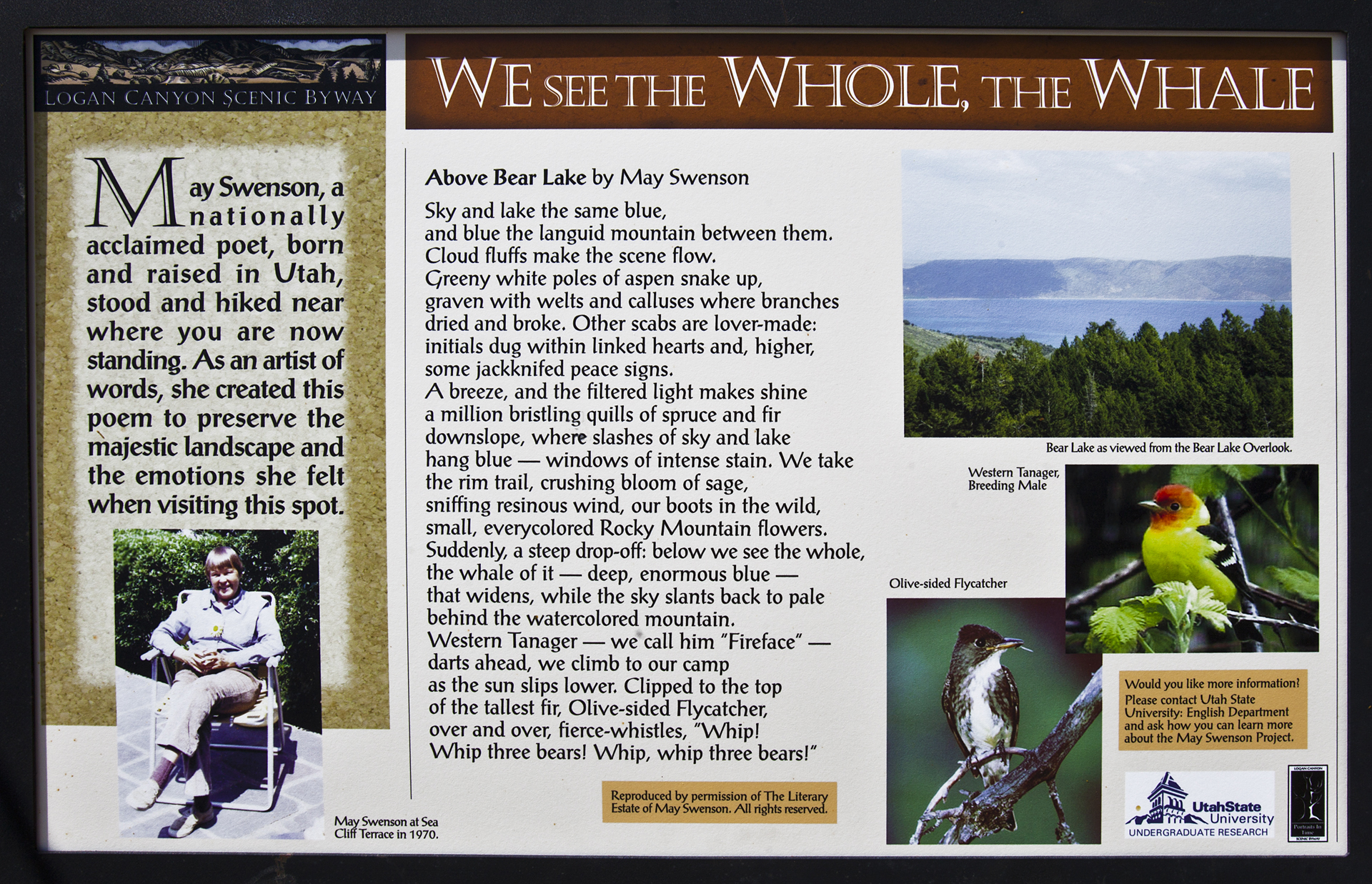USU Scholars Celebrate May Swenson at Bear Lake Overlook
On the shoulder of Highway 89 at the top of Logan Canyon, a birthday party of sorts took place May 28, 2011.
To commemorate what would be the 98th birthday of Utah’s most accomplished poet May Swenson, Utah State University scholars installed a panel of her poem “Above Bear Lake” at the overlook, marking the latest step in an ongoing effort to celebrate her poetry and her legacy.
“Logan is May Swenson’s birthplace,” said Natalie Hatch (’12), who helped create and secure the funding for the panel. “It’s important for us to recognize that she is someone who did so much by way of literature and that she came from here, she was educated here. May Swenson transformed what people thought of poetry.”
Anna Thilda May Swenson was born at the base of Old Main hill in 1913 and studied English at Utah State Agricultural College, now USU. She graduated in 1934 and went on to publish 11 books of poetry and won the prestigious MacArthur Fellowship, also known as the ‘Genius Grant’ in 1987. Despite her literary achievements, Swenson’s poetry has been under appreciated by academic audiences in part because she never published an edition of her complete poems, and she remains only quietly heralded by her hometown. The May Swenson Project at USU aims to change that.
“She was a blue collar poet in that she was in the trenches,” said Paul Crumbley, a professor of English who directs the project. “She never wanted to be affiliated with one genre or with the university [poets].”
Swenson experimented with form and wrote on a range of topics from nature, physics and philosophy to baseball, love and religion. The purpose of the May Swenson Project is to raise awareness and scholarship of her work at USU and throughout the Cache Valley community. Over the years, students have helped develop a May Swenson room in the Merrill Cazier library and organized a poetry symposium in her honor. The latest effort has taken five years and two undergraduates to navigate the proper bureaucratic channels for permission and funding.
Natalie Hatch, an Undergraduate Research Fellow, was first exposed to Swenson as a freshman while working with Joyce Kinkead, associate vice president for research. The more she read about Swenson, the more captivated she became.
“May Swenson broke all the barriers and made it her style,” Hatch said. “I learned that with poetry you can write about anything. You can play with form, you can play with words, you can play with punctuation. It doesn’t have to be unreadable. May Swenson really opened my eyes to the possibilities of what one author can do.”
Since 2008, Hatch has worked alongside Crumbley to increase public appreciation for the poet. She jumpstarted the installation project at the Bear Lake Overlook which had been stalled due to limited funding support. Hatch was awarded an Undergraduate Research and Creative Opportunities grant in 2009 for her proposal “May Swenson’s Verbal Artistry: The Power of Her Northern Poetry.” The grant will help pay for the installation.
“We really want people to know who May Swenson was and that she is really important to this area,” Hatch said. “She did so much, but she came from here. There is no place like Cache Valley in the world. [May Swenson showed that what you do] doesn’t have to be big and loud, it just has to be meaningful.”
Swenson was the oldest of 10 children born to Swedish immigrants. A year after graduating from USU, she borrowed $200 from her father and moved to New York City with her cousin.
“She always knew that she was a poet, and I think to be able to identify with all types of people she thought she would have to meet other types of people,” Hatch said. “She was very well traveled, but she always came back here. From her poems you can see that Utah was kind of an anchor for her.”
Swenson wrote “Above Bear Lake” during a return visit to Logan. It invokes the connection she still felt for the place she left decades before to find herself and her path to writing. Hatch hopes that the poem will serve as a gateway for others to be exposed to her work and to poetry.
“People are afraid of poetry,” Hatch said. “They immediately think of Shakespeare and that scares a lot of people. May Swenson wrote poetry anybody could read.”
Hatch researched Swenson to craft the installation and met with officials from the National Forest Service, Utah Department of Transportation, the Scenic Byway Committee and the Stokes Nature Center for approvals. The project was perfect for Hatch because she plans to get her master’s degree in library science to teach others how to find information that will help them learn and grow.
“Since elementary school I’ve known that there is great power in literature,” Hatch said. “This is putting literature and the power of literature into a public space. I’m excited to see it come to fruition.”
As the May Swenson Project unfolds, USU scholars aim to make the university a center for May Swenson studies, to show others what is possible and to celebrate the life of a Logan resident who moved away but never really left.
May Swenson is buried in the Logan City Cemetery.
For Crumbley, making May Swenson’s poetry more accessible to the public is important because of the possibility she represents, he said.
“I think that people who have aspirations to do their own writing feel inspired by May Swenson.”

